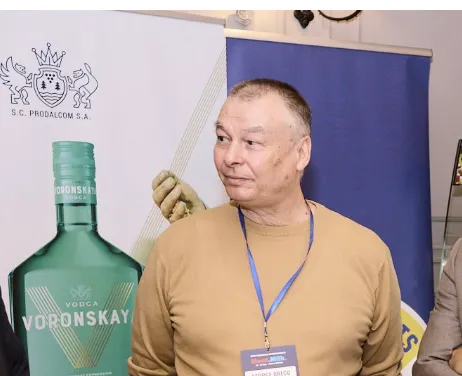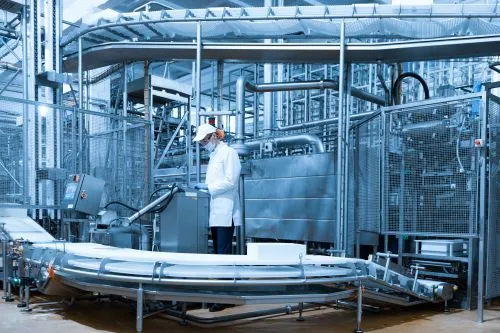1859

A biofilm is a structured community of microorganisms, such as bacteria, fungi, algae, or protozoa, that attach to a surface and are surrounded by a protective EPS (extracellular polymeric substance) matrix. This matrix, composed of polysaccharides, proteins, DNA, and other molecules, provides structural support and protection for the microorganisms in the biofilm.
The formation of a biofilm usually occurs in several stages, summarized graphically in Figure 1 below: (1) attachment of microorganisms to a surface, (2) growth, colonization, and development of the extracellular matrix, (3) maturation of the biofilm structure, and then (4) dispersion, where two types are distinguished:
A. Release of bacteria in free form
Or
B. Detachment of a whole biofilm fragment - bacteria + protective matrix, which can thus reattach and contaminate equipment or products in a new area.
Although many players in the food or beverage industry may not realize this risk, it is highly likely that they have already encountered or will encounter problems caused by biofilms in the future, as over 90% of bacteria are capable of protecting themselves by forming such a biofilm. Among these, mention should be made of pathogenic bacteria such as Salmonella, Campylobacter, Listeria monocytogenes, or spoilage bacteria such as Brochothrix thermosphacta, Leuconostoc, Pseudomonas, or Bacillus.
The hidden threat to the Food & Beverage industry
The problem for the food or beverage industry is that the biofilm is not visible and cannot be detected by conventional monitoring methods - a common scenario is that disinfectants neutralize all free (unprotected by biofilm) bacteria, so routine microbiological tests show no bacterial presence. However, colonies under the protection of the biofilm can erupt at any time.
For example, we can identify three scenarios in which the presence of bacteria may evade routine tests: samples taken after the normal cleaning cycle may not contain bacteria, either because all free bacteria have been eliminated, leaving only those inside the biofilm attached to surfaces, or an isolated biofilm has erupted, but the respective microorganisms were not present at the time and place of sample collection.
Another possibility is that the bacteria contained in the sample taken may be in the VBNC (Viable but Non-Culturable) mode - Viable but Non-Culturable bacteria. VBNC bacteria are in a state similar to hibernation, do not reproduce, and have low ATP values, leading to difficulties in identifying them through traditional analyses, such as Petri dishes or ATP2G. However, they become active again and can multiply once they come out of the "hibernation" state. Thus, we can encounter a scenario where normal tests show no bacterial presence, but it suddenly appears at a later time.
In addition to the difficulty of detecting biofilms, they provide bacteria with extremely resistant protection, acting as a shield against any form of external aggression, from mechanical to chemical or even thermal. Studies show that bacteria under the protection of the biofilm are 10 to 1000 times more resistant to chemical cleaning agents, by far the most commonly used in the F&B industry.
Therefore, the biofilm represents a hidden but constant risk of contamination, as it is impossible to anticipate when it will erupt and release a wave of bacteria or biofilm fragments into the working environment or even onto the finished product.
BIOREM - Solution for biofilm removal and prevention
Recent studies show that the most effective method of dissolving the EPS matrix of the biofilm and allowing biocidal substances to reach bacteria is through enzymatic detergents.
Realco, a Belgian company, has developed and patented the Biorem(Biofilm Removal) product range, a unique range of solutions specially formulated for biofilm removal. Realco, together with its representative in Romania, Romfracht, not only offers biofilm removal solutions per se but can also support you with related services for detecting biofilm presence, characterizing the present bacteria, treating it, and preventing its reappearance:
Thanks to dedicated analysis methods, we can:
- Confirm or refute the presence of biofilm on open surfaces (OPC) using the dedicated Biofilm Detection Kit®
- Confirm or refute the presence of biofilm in closed circuits (CIP) using a specific treatment protocol and specific analyses performed at several key stages during cleaning
- Characterize all microorganisms present inside the biofilm, regardless of whether they are VBNC or not
- Analyze the effectiveness of the applied treatment
- Recommend a specific preventive protocol for each case
Another unique advantage of Biorem solutions is that they maintain a neutral pH and moderate temperature (45-55°C) throughout the treatment, which, in addition to the advantages related to sustainability and labor protection, allows us to take samples at various stages of treatment. Thus, we can not only treat the present biofilm and remove the risk of contamination but also analyze the microorganisms present in it.
With 25 years of experience and major achievements in Europe and North America, Realco is now proud to announce that its expertise is available in Romania through Romfracht.
Romfracht, a company with 100% Romanian capital and 27 years of market experience, as Realco's local partner, offers Biorem enzymatic solutions for biofilm removal on the Romanian market. Additionally, we can provide enzymatic solutions for wastewater treatment - for septic tanks, grease separators, or pipes and drains, or for professional cleaning in the industrial or HORECA sector.
For any additional information and/or an audit, do not hesitate to contact us: [email protected] or +40 21 256 16 42
[1]Richards, J. J., & Melander, C. (2009). Controlling Bacterial Biofilms. ChemBioChem, 10(14), 2287–2294. https://doi.org/10.1002/cbic.200900317
[2]Ramamurthy T, Ghosh A, Pazhani GP, Shinoda S. (2014). Current Perspectives on Viable but Non-Culturable (VBNC) Pathogenic Bacteria. Front Public Health.Jul 31;2:103. https://doi.org/10.3389/fpubh.2014.00103
[3]Farhat, M., Alkharsah, K. R., Alkhamis, F. I., & Bukharie, H. A. (2019). Metagenomic study on the composition of culturable and non-culturable bacteria in tap water and biofilms at intensive care units. Journal of Water and Health, 17(1), 72–83. https://doi.org/10.2166/WH.2018.213
[4]Shakeri, S., Kermanshahi, R. K., Moghaddam, M. M., & Emtiazi, G. (2007). Assessment of biofilm cell removal and killing and biocide efficacy using the microtiter plate test. Biofouling, 23(1–2), 79–86. https://doi.org/10.1080/08927010701190011





